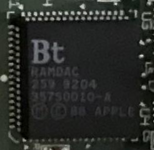eharmon
Well-known member
Picking up from this thread: https://68kmla.org/bb/index.php?threads/supermac-pdq-spectrum-8-24-thunder-roms.42656/post-505422
I'm a bit confused (and not real familiar with RAMDACs) -- it indicates it's designed for 16-bit graphics at 1152x870, but it refers to supporting 24-bit frame buffers.
So maybe a RAMDAC swap would Just Work™ (which is pretty neat), but the fact that it seems like you can send 24-bit graphics data into the AC843 is curious.
Aaaaah. I didn't realize they switched RAMDACs. Looking at the reference though (https://bitsavers.org/pdf/apple/mac/video/DAFBII_ACDC.pdf):The video DAC is the main difference. AC842 does 1/2/4/8/24 bit, and AC843 does 16 bit but not 24. That is auto-detected by the driver as well, so if you had a spare DAC from a battery bombed Q700 or 900, you could theoretically drop it into a Wombat (and extend the VRAM to 2 MB) and have 24 bit (the pinouts are the same).
And:The AC843 is designed specifically tor Apple graphics needs of the future. The architecture
. . . . /ena5Te~rthe._display o f u p t o 1 1 5 2 x ~7.0-blr-mappesl c o l o r g r a p h i c s ( u p t o 1 6 b i t s pe~.f)ix~I). Tbe·multiple pixel ports and interl)af mul~.ipfe-xmg enabJ.es TTL comp3:~ib~~..!!:l!edaciflg (u~to ,64 MHz)\ to the kame buffer, while maintaining.100 MAz video dataates at 1, 2, 4, 8, or
/16 bits per pixel. 24 bit chunky"planar rtlultiplexirig enables a 24 bit or··t2·bit~hunky pla~r
' frame bufier to maintain 64 ~Hz video data rates~. 24 bit mode enables a 32 bit frame b~ffer
(upper byte ignored) °'to maintain 64 MHz video data rates. Convolved video d~ta can ~ maintain a rate of 16 MHz.,' · .
The AC84~contains t~iple'256 x 8 colbr lookup tables with triple 8-bit video oJA convertJrs. On chip fe~tures inclu~e ,4.pple convoiution, 8 bit psuedo colo,r lookup or triple! 8 bit lookqp for 16 andi24 bit modes, dhunky, and\chunky planar multiple~ing, and built in logic block
observaticr-
Unfortunately OCR has done...poorly...in the first paragraph.The AC843 supports the same MPU signal definition and timing as the AC842, but slightly different internal, control register addressing to accommodate the extended functionality. As illustrated in Table 7, the read and write functionality of the internal address register, the color look up table and the test register remain the same as defined in the AC842 spec.
I'm a bit confused (and not real familiar with RAMDACs) -- it indicates it's designed for 16-bit graphics at 1152x870, but it refers to supporting 24-bit frame buffers.
So maybe a RAMDAC swap would Just Work™ (which is pretty neat), but the fact that it seems like you can send 24-bit graphics data into the AC843 is curious.

